
Hardwick General Contracting in Maitland is building Casa las Flores using green guidelines.
Green Florida: Anatomy of a Green Home
Can a luxurious home be a green home? Absolutely. These days, green construction doesn’t mean sod roofs and windmills.
Thanks to modern building materials and technologies, the most eco-friendly homes don’t necessarily look any different from surrounding homes. They do act differently, however.
Take, for example, this elegant charmer, now under construction on an infill lot in Orwin Manor. The historic Orlando">Orlando neighborhood was first developed in the 1920s—yet this home fits right in.
Hardwick General Contracting in Maitland is building the 3,700-square-foot Casa las Flores using guidelines from several organizations, including the Florida Green Building Coalition, Florida Water Star and Energy Star. The four-bedroom, three-and-a-half bathroom home is planned to be registered with the Department of Energy Builders Challenge.
Upon completion, the home will be approximately 50% more energy efficient than a typical home, with an emphasis on resource conservation, nontoxic and recycled products, natural materials and Florida-friendly landscaping.
So, what makes a green home green? Since Casa las Flores is under construction, we thought we’d take you on a tour of the home and site and point out its green features.
What Makes a Green Home Truly Green?
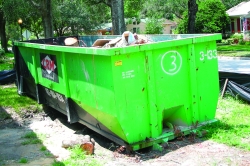 1. Recycling construction waste. Glass, cardboard, wood, metal, concrete and other construction waste is sent to a recycling center instead of the landfill.
1. Recycling construction waste. Glass, cardboard, wood, metal, concrete and other construction waste is sent to a recycling center instead of the landfill.
2. Erosion control. Special fencing was built around the site and hay bales were placed at access points to prevent erosion and storm water runoff and to keep from contaminating surrounding properties.
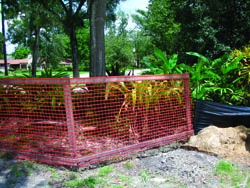 3. Saving the trees. Fences were placed around existing trees and on neighboroperties to protect the trees and their root systems.
3. Saving the trees. Fences were placed around existing trees and on neighboroperties to protect the trees and their root systems.
3. Southern exposure. Situating a house so that it faces south prepares it for the addition of solar panels now or in the future.
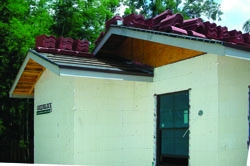 4. Roof protection. The ZIP Wall system is a durable, moisture-resistant barrier system that also promotes energy efficiency by helping to maintain the R-value of the home’s insulation. ?It also contains no urea formaldehyde, which helps promote indoor air quality and meet the requirements of the Sustainable Forest Initiative Program.
4. Roof protection. The ZIP Wall system is a durable, moisture-resistant barrier system that also promotes energy efficiency by helping to maintain the R-value of the home’s insulation. ?It also contains no urea formaldehyde, which helps promote indoor air quality and meet the requirements of the Sustainable Forest Initiative Program.
4. On the roof. Concrete roof tiles are ENERGY STAR?-certified and sourced from a local company, which mean less energy was used to transport the product.
4. Overhangs. Two-foot-deep overhangs divert rain away from the home and prevent solar heat gain, which means air conditioning systems don’t have to work as hard.
4. Insulated Concrete Forms. Greenblock Insulated Concrete Forms create steel-reinforced concrete wall systems that are storm-resistant and energy-efficient. ICFs, which also help to block outside noise, are made from a nontoxic expandable polystyrene that can be recycled.
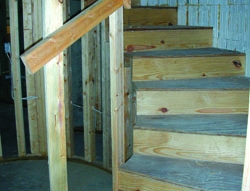 5. Reuse. Reusing plywood from another jobsite saved the crew from using about 35 new sheets on the home’s steps and dome.
5. Reuse. Reusing plywood from another jobsite saved the crew from using about 35 new sheets on the home’s steps and dome.
?
?
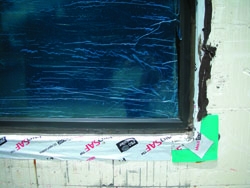 6. Windows and doors. Using windows and doors that exceed Energy Star ratings will lower energy bills. Windows are sealed and taped for even more efficiency.
6. Windows and doors. Using windows and doors that exceed Energy Star ratings will lower energy bills. Windows are sealed and taped for even more efficiency.
?
?
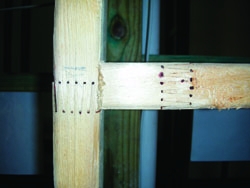 7. Framing the house. Engineered wood products and materials such as finger-jointed studs are more dimensionally stable than solid-sawn studs, and they preserve resources because they’re made of wood remnants.
7. Framing the house. Engineered wood products and materials such as finger-jointed studs are more dimensionally stable than solid-sawn studs, and they preserve resources because they’re made of wood remnants.
7. Treated wood. Borate pressure-treated lumber is non-toxic and protects against termites, insects and fungal decay including dry rot.
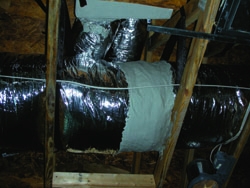 8. Ducts. Duct joints are sealed with mastic inside and out to prevent air leaks; a “smoke” test reveals any leakage problems.
8. Ducts. Duct joints are sealed with mastic inside and out to prevent air leaks; a “smoke” test reveals any leakage problems.
8. Indoor air quality. ENERGY STAR?-certified bathroom exhaust fans will remove humidity and pollutants from the home and prevent mold and mildew. A central vauum system will remove allergy-causing dust.
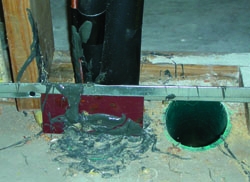 9. Nontoxic sealants. To help maintain indoor air quality, low-VOC (volatile organic compound) sealants are used on any cuts made in the slab for plumbing and electrical work and on PVC pipes
9. Nontoxic sealants. To help maintain indoor air quality, low-VOC (volatile organic compound) sealants are used on any cuts made in the slab for plumbing and electrical work and on PVC pipes
